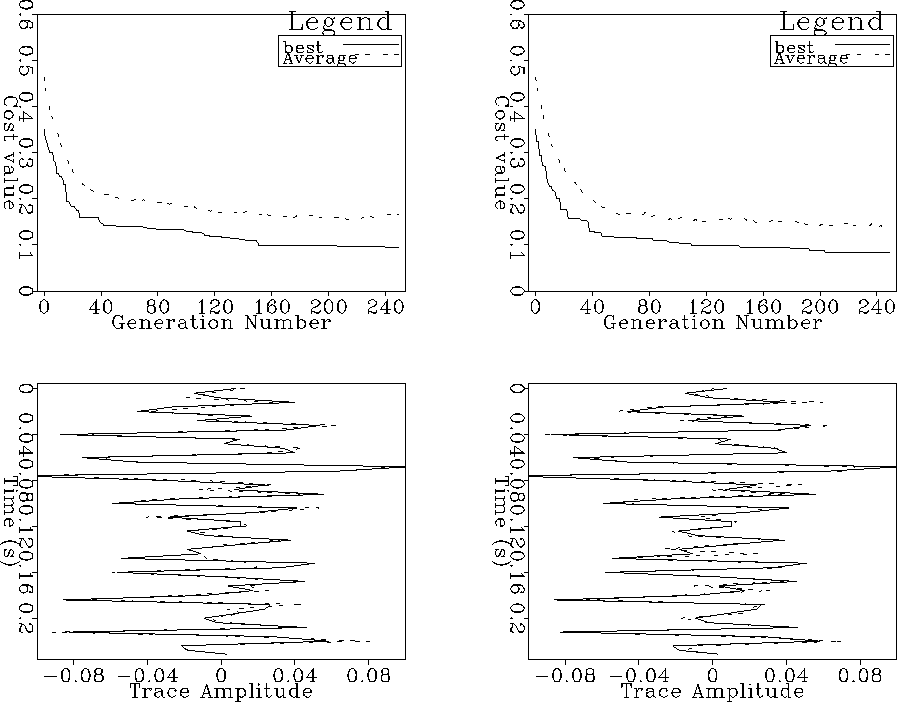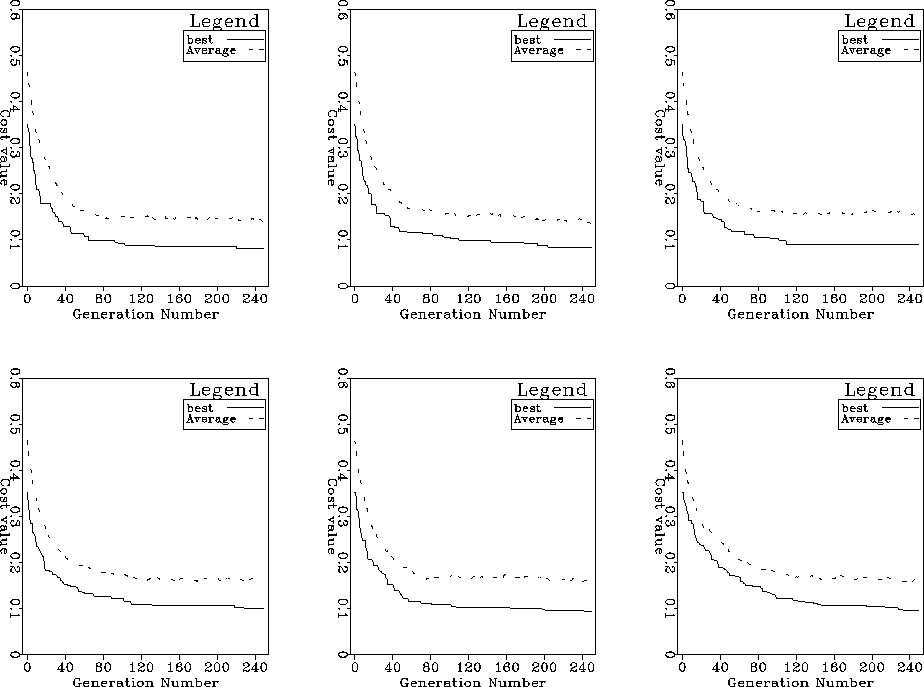




Next: Mutation
Up: Parameter Selection
Previous: Selection Mechanism
Crossover is by far the most important evolution operation. I tested
single-point and uniform crossover with a crossover probability
of 0.6. The population size was chosen to be 200 and the algorithm was run for
250 generations. The jump mutation was set at 0.005 and the creep mutation
at 0.05. Elitism of the best individual as well as niching was allowed.
The top panels in Figure ![[*]](http://sepwww.stanford.edu/latex2html/cross_ref_motif.gif) show the
convergence rate of the two cases, whereas the bottom panels show the
corresponding traces. In this case uniform crossover
(right panel) performs a little better since it reaches a lower cost-value
after the allowed number of cost-function evaluations. Using uniform crossover,
I tried six different values of crossover probability: 0.5, 0.6, 0.7, 0.8, 0.9
and 1.0. I tried this large range of values because crossover rate is a
particularly important evolution parameter. The top panels of
Figure
show the
convergence rate of the two cases, whereas the bottom panels show the
corresponding traces. In this case uniform crossover
(right panel) performs a little better since it reaches a lower cost-value
after the allowed number of cost-function evaluations. Using uniform crossover,
I tried six different values of crossover probability: 0.5, 0.6, 0.7, 0.8, 0.9
and 1.0. I tried this large range of values because crossover rate is a
particularly important evolution parameter. The top panels of
Figure ![[*]](http://sepwww.stanford.edu/latex2html/cross_ref_motif.gif) show the comparison of the convergence
rates for crossover rates of 0.5, 0.6 and 0.7 whereas the bottom panels show
the same curves for crossover rates of 0.8, 0.9 and 1.0. The results are
surprisingly similar, although it appears that the smaller crossover rates
produce faster initial convergence, and so I chose a crossover
rate of 0.6 for the remaining tests.
SG_compare_crossover1
show the comparison of the convergence
rates for crossover rates of 0.5, 0.6 and 0.7 whereas the bottom panels show
the same curves for crossover rates of 0.8, 0.9 and 1.0. The results are
surprisingly similar, although it appears that the smaller crossover rates
produce faster initial convergence, and so I chose a crossover
rate of 0.6 for the remaining tests.
SG_compare_crossover1
Figure 5 Comparison of convergence
rates for two types of crossover: single-point (left) and uniform (right). Top
panels are convergence rates whereas bottom panels are trace match with
continuous line representing the reference trace and dotted line the inverted
trace.




 SG_compare_crossover2
SG_compare_crossover2
Figure 6 Comparison of convergence
rates for different crossover rates. Top panels correspond to crossover rates
of 0.5, 0.6 and 0.7 whereas bottom panels correspond to crossover rates of
0.8, 0.9 and 1.0.










Next: Mutation
Up: Parameter Selection
Previous: Selection Mechanism
Stanford Exploration Project
11/11/2002

![[*]](http://sepwww.stanford.edu/latex2html/cross_ref_motif.gif) show the
convergence rate of the two cases, whereas the bottom panels show the
corresponding traces. In this case uniform crossover
(right panel) performs a little better since it reaches a lower cost-value
after the allowed number of cost-function evaluations. Using uniform crossover,
I tried six different values of crossover probability: 0.5, 0.6, 0.7, 0.8, 0.9
and 1.0. I tried this large range of values because crossover rate is a
particularly important evolution parameter. The top panels of
Figure
show the
convergence rate of the two cases, whereas the bottom panels show the
corresponding traces. In this case uniform crossover
(right panel) performs a little better since it reaches a lower cost-value
after the allowed number of cost-function evaluations. Using uniform crossover,
I tried six different values of crossover probability: 0.5, 0.6, 0.7, 0.8, 0.9
and 1.0. I tried this large range of values because crossover rate is a
particularly important evolution parameter. The top panels of
Figure 